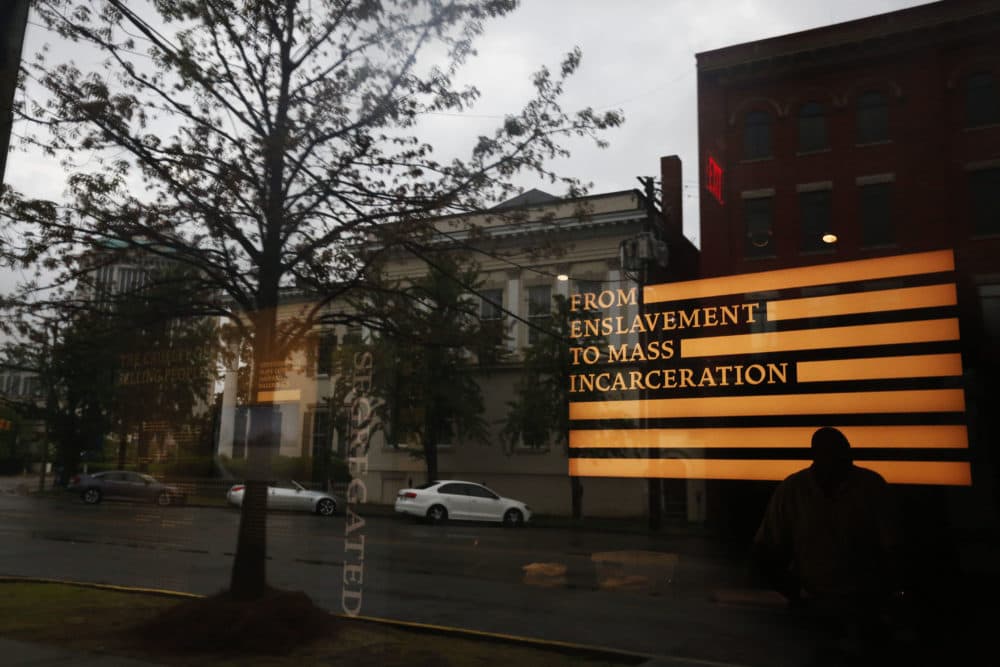Advertisement
Commentary
The Direct Line Between Slavery And Racism In Boston

Wanting to understand more about our nation’s past, my husband and I and two friends recently traveled to Alabama, to visit the heartland of American slavery. We briefly stopped in Selma but spent more of our time in Montgomery, exploring both the Legacy Museum and the National Memorial to Peace and Justice.
The lesson I carried home after two days of painful, hard looking was not so much about Alabama’s history, though it is ugly. The lesson I took was about the work Massachusetts still must do if we are ever to reckon with slavery in our past.
It’s important to visit the Civil Rights memorials in the South, but naïve and distorting to overlook the part played by the North in this history. Yes, Boston has a small Museum of African American History in Beacon Hill, but I departed Montgomery convinced that our city needs its own legacy museum. And, as a friend pointed out, so do a lot of other northern cities.
When you live with a false story about your nation’s past ... developing an informed consensus for action becomes extremely difficult.
Many people like to say — glibly and dismissively — that slavery is behind us, that African Americans need to move on and that racism is no longer relevant. Such claims are not even a little true. Rather, they are fear-filled and inaccurate — and impede us in facing the history that is documented and factual, and that continues to impede not just the lives of slavery’s descendants, but all of us.
When you live with a false story about your nation’s past — as well as what Bryan Stevenson, the founder of the Equal Justice Initiative (and the museum and monument) has famously called a “false narrative” about racial difference — developing an informed consensus for action becomes extremely difficult.
The Legacy Museum, subtitled, “From Enslavement to Mass Incarceration” is trying to help Americans understand the “legal” and extra-legal terrorism and repression — long disavowed by white America — that runs like a highway from the past to the present; and that exists, and always has existed, to keep African Americans from gaining access to equal justice, equal economic opportunity, equal housing or equal education.
Downtown Montgomery, the state capitol, and home to the museum is — at least in January — a ghost town. Visitors stick out. As we walked here and there, people stopped us to talk.
We spoke with a man whose family had lived for generations in Alabama, and whose great aunt and others in his family, he told us, had involvement in more than one lynching. He described his own liberalism as “a blue dot in a red sea.”
The second conversation was initiated by a woman originally from New Jersey who’d spent her adulthood with her Alabama husband in Selma. “We are famous worldwide,” she said with tears in her eyes, “for our worst behavior, our worst day.”
What each person said felt genuine and I was grateful for the conversation. But listening to their shame is not enough. It is time we brought the lessons home and faced our own legacy. And not just by building a memorial to the Rev. Martin Luther King Jr. Were he able to weigh in today, I suspect he’d be the first person to worry that he was in danger of being sentimentalized as a way to avoid the real reckoning.
Massachusetts outlawed slavery in the early 1780s, and the state is justly proud of its white abolitionists, including William Lloyd Garrison, and is increasingly aware of the black abolitionists to whom it offered a home, figures like Prince Hall (c.1735-1807) and David Walker (c.1796-1830).
We have not been as eager to reflect deeply upon the fact that in 1641 the Massachusetts Bay Colony was the first to legalize slavery, and that it helped Colonial slavery take root and develop.
As early as 1638, with Gov. John Winthrop’s blessing, the Massachusetts Bay Colony began enslaving and trading captured Pequot Indians, whose land the colonists wanted to take. A ship called The Desire, captained by a Salem merchant, a Mr. Pierce, sailed to the Caribbean where he sold 17 Pequot captives. In exchange, Pierce carried home cotton, tobacco, salt and “negroes” to sell in Boston.
It is time we brought the lessons home and faced our own legacy.
In her book about the link between the Bay Colony’s enslavement of Native Americans and the larger development of American slavery, historian Margaret Ellen Newell argues that Massachusetts actually “created precedents and strategies” that influenced the development of slavery in other places.
Much wealth was made for New Englanders by trading enslaved people, or from selling New England goods to help slavery prosper in the south. To name a few truths among many: In the 18th and 19th centuries, Massachusetts sold tons of salted fish to feed enslaved workers in the Caribbean; old Boston families got rich transporting Africans; and the famous Lowell Mills didn’t just buy cotton from Southern plantations, they sold back rough cloth to clothe enslaved people.
If you research and read, you can piece together the story. But to change the way people think, it needs to be gathered into one place and made available for all to see.
Boston needs coherent exhibits, pictures and narratives so that we can finally understand how the poverty, inferior public education, inadequate medical care and redlining imposed on our black citizens — and well documented in the Boston Globe’s 2017 Spotlight series, “Boston. Racism. Image. Reality.” — is not happenstance, but part of a long road that begins with a series of decisions when Europeans arrived in Massachusetts almost 400 years ago.
In 2020, when we celebrate the 400th anniversary of the Pilgrims’ arrival in Plymouth, let’s use the occasion to begin telling a more authentic story about our past.
Let’s break ground on a Boston Legacy Museum.

